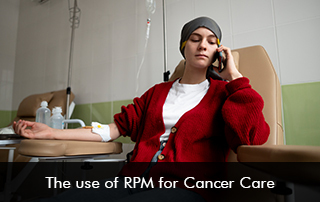After the COVID-19 pandemic, it become difficult to proceed with in-person hospital visits. As the coronavirus cases increased in hospitals, there were concerns about unmet chronic care needs. Especially for patients suffering from cancer.
The pandemic and cancer care
These concerns became true. A study published in November 2020 revealed that because of the COVID-19 pandemic there were significant lags in identifying new cancers in patients and therefore a delay in treatment. A more recent study shows that care gaps remain in cancer screenings. Cancer patients must receive timely treatment to control its spread to other parts of the body and make treatment a successful journey.
RPM tools for effective care for cancer patients
As in-person restrictions grew, hospitals started to leverage virtual care solutions to offer continued care to their patients remotely. Healthcare organizations started using Remote Patient Monitoring (RPM) tools to extend cancer care into patients’ homes.
Some healthcare organizations were able to scale up their current RPM programs for cancer care because of the regulatory flexibilities during the pandemic. While other organizations started new remote patient monitoring programs with the help of grants and new funding.
Challenges in implementing RPM tools for cancer care
Implementing a remote patient monitoring program can benefit cancer patients as they can receive timely care from the comfort of their homes and only come to the hospital when necessary. However, implementing RPM tools in the cancer care arena has a few challenges including,
- Limited technology access.
- Physician pushback.
- Non-existent reimbursement structures.
How cancer providers are using RPM technology in different ways
Hospitals that offer cancer care are deploying the power of remote patient monitoring tools to expand care access and reduce the occurrence of adverse events.
Huntsman Cancer Institute in Salt Lake City is using RPM programs for symptom management and hospital-at-home programs. The symptom management program helps to monitor the symptoms of patients undergoing chemotherapy. An interactive voice response (IVR) system is used by patients to inform providers about their symptoms daily and rate the severity. The robust system has an alert feature that signals the care team if symptoms get severe, so they can take the right action at the right time. This supports effective cancer symptom management. The cancer institute started with a hospital-at-home program in 2018 to expand care access to acute care to avoid ED visits and re-hospitalizations. The program included both on-site and telehealth-enabled nurse practitioner visits.
Ochsner Health System in New Orleans also deployed RPM tools to support cancer patients undergoing chemotherapy sessions. The program launched in 2019 offered patients a blood pressure cuff and thermometer. Patients get the devices for free from the Ochsner digital technology hub and the technicians help patients how to use these devices. Patients also submit their vital signs twice daily through the health system’s app. This way clinicians can be informed in real-time and intervene to prevent an adverse situation.
Virtual care solutions like Telemedicine EMR Software and the use of remote patient monitoring tools have the power to improve cancer care and even enhance health outcome levels. It is important to encourage the development of payment models and quick coverage expansion to support the use of RPM tools in the cancer care arena. This can be done by collecting data that shows the benefits of leveraging RPM technology in cancer care.






